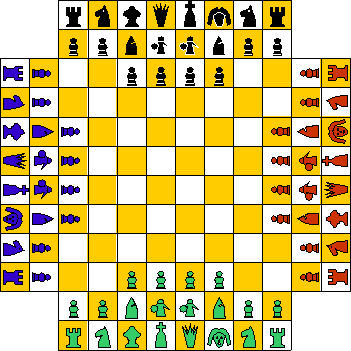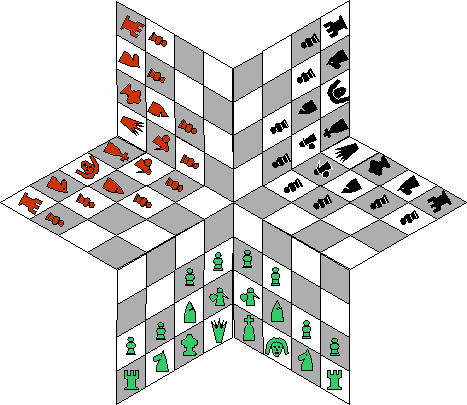Check out McCooey's Hexagonal Chess, our featured variant for May, 2025.
Check out McCooey's Hexagonal Chess, our featured variant for May, 2025.
Eric Wouters (from the Netherlands) invented this chess variant for four players in 1994; these rules were last modified in 1995. The game has been played a few times.
The goal of the games is to sjahmate (like checkmate) the King of the opponent(s). If the game is played with three players, once a players King is sjahmate, he or she is out of the game. His or her pieces will be removed from the board. The others continue. If played with four, Green and blue team up against red and black. The goal here is to sjahmate one of the other Kings.
There are four colours: Green, blue, red and black. There are 20 pieces of each colour. Most of them are like normal chess pieces such as:
| The King | (K) | (1) |
| The Queen | (Q) | (1) |
| The Advisor (often called the bishop) | (A) | (2) |
| The Knight or Horse | (H) | (2) |
| The Rook | (R) | (2) |
| The Pawn | (() | (8) |
There are four pieces extra in this game, to make the game more interesting. They are:
| The Prince | (P) | (1) |
| The Princess | (Ps) | (1) |
| The Bodyguard | (B) | (2) |
The well known pieces all make movements like in normal chess.
The Princess can move diagonal or one field vertical or horizontal.
The Prince can move vertical, horizontal or one field diagonal.
The Bodyguards can move maximal two steps in each direction.
Since the board of the game for three persons is oddly shaped, determining what the correct move is can cause some problem. Therefore the following definitions:
Moving in a straight line means that you pass lines which are opposite of the one you passed before. Moving diagonally means passing a cross which is opposite of the one you crossed before.
Appendix 2 gives examples of how pieces may move and how they may not move. (This is not yet drawn!)
The game is played in the sequence: Green, Black, Blue and Red.
Below, you see the boards, and setups for the game with four and with three players. When playing with two players, use the board for four players and leave the pieces of two players at opposing sides out.


You may not take pieces of the colour you play with, but you may take a piece of your mate. In case the game is played with four persons the most left or right Pawn can take an opponents Pawn as there first move. This is not allowed. Taking with a Pawn means it will keep colour, this is important in case the Pawn is in the middle of the three players board. See also appendix 2. (Not yet drawn.)
Only the Pawns can promote.
When a player is in sjah, sjah should be raised after he or she made a move. This means that also his mate or an other opponent may raise sjah, provided that his or her turn is before the turn of the player who is in sjah.
Eric Wouters
Het Wilgert 32
7214 AV Epse
The Netherlands
0575-492409
Move Eric Maarten Fred Evert
nr. Green Black Blue Red
1 H3-H5 G10-G9 B4-D4 J7-H7
2 E3-E5 F10-F9 C8-D8 J8-I8
3 E2-C4 F11-F10 C7-E7 K8xH5
4 E1-E4 H11-I10 B8xE11 K5xH2 Sjah
5 H1xH2 Sjah E12xE11 A7xE11 L5-K5
6 C4xI10 Sjah J11xI10 E11xF12 Sjah L8-J8
7 F1-C4 G11xF12 B6-C7 L7-K8
8 D1-E3 I12-G11 A4-B6 K7-J7
9 G1-E1 G11-H9 B6-D7 L9-K7
10 H2xK5 Sjah D12-F11 A9-C8 K6-K5
11 I1-H3 H12-G11 C8-E9 L6-L8
12 E4-F5 G12-I12 E9xD11 H5-E8
13 H3-G5 F12-D10 D11xF10 K7-I6
14 E3-G4 G11xF10 A5-B6 I6xG5
15 F5xG5 C12-D12 A6-A4 K3-J3
16 G4-F6 H12-G12 B10-C10 E8-G6
17 F3-F5 G12-E12 B9-C9 G6xC10
18 C4-F7 D10xD8 A10xC10 J3xI2
19 G2xI2 D8xC7 B6xC7 J8-I7
20 J1-I1 G9-G8 C10xC11 J6-H6
21 G5xG8 E12-E11 C7xF10 H7xG8
22 F7-C10 H9xF10 C11xE11 I7xE7
23 F6xG8 F10xG8 E11xF11 J7-I6
24 C10-C11 D12-H12 F11xI11 Sjah L7-J7
25 C11-G11 I12-J12 D4-E4 E7*D7
26 G11*H2 MATE